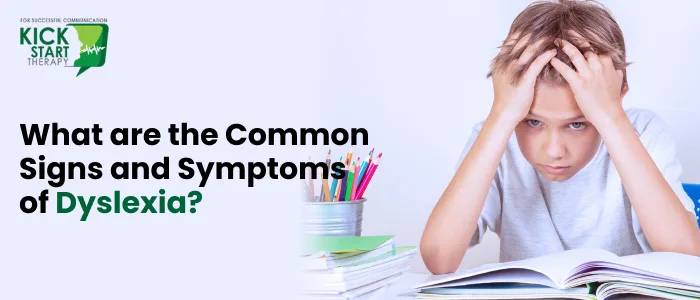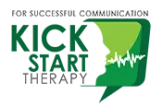
Many people think dyslexia is a challenge with reading only, but in reality, it can cause trouble with speaking, writing, and even understanding. That can make it hard to spot the symptoms of dyslexia, especially in children.
Children with dyslexia often show symptoms before they start their academic journey. They might talk later than most of their peers, have trouble learning even simple rhymes, or struggle to follow directions. And once they start schooling, they may struggle with reading, writing, and spelling.
Through this simple guide for parents, we will discuss the common signs and symptoms of dyslexia in children, how to recognize them early, and what practical steps you can take to support your child.
What Exactly is Dyslexia?
Dyslexia is a learning disability that mainly affects reading, but it can also impact writing, spelling, and even speaking. In simple terms, the brain of a dyslexic individual processes language in a different way. This can make reading slow, tiring, or confusing, and sometimes words or letters may appear jumbled.
Dyslexia symptoms usually start to show up in childhood. Some early signs include trouble learning simple rhymes, remembering the names of letters, or following instructions. Children might also take longer to recognize familiar words or read aloud.
It is important to note that the condition can vary a lot from child to child. Some children may only struggle with reading, while others may also find writing, spelling, and even talking clearly more challenging. It can also affect how quickly a child processes information or remembers sequences, like days of the week or phone numbers.
What are the Signs and Symptoms of Dyslexia in Children?
Dyslexia can show up differently at various ages. Noticing the signs early can help children and adults get the support they need. Here are the common symptoms broken down by age group:
Signs and Symptoms of Dyslexia in Preschoolers
Even before school, some signs of dyslexia may be noticeable:
- Difficulty learning or remembering letters of the alphabet
- Mixing up letters and words when reading or writing
- Mispronouncing familiar words
- Trouble distinguishing similar letters, such as “t” and “d”
- Struggling to recognize rhyming patterns, like in simple nursery rhymes
- Falling behind peers in language and communication skills
Signs and Symptoms of Dyslexia in Elementary School
- As children start reading and writing in school, dyslexia often becomes more visible:
- Reading slower than classmates
- Difficulty connecting letters to the sounds they make
- Trouble sounding out words when reading
- Writing letters or numbers backward, such as “b” instead of “d”
- Slow writing speed
- Frequent spelling mistakes, even with simple words like “dog”
- Words seem to jump around on the page
- Difficulty following multi-step instructions
Dyslexia Symptoms in Later Childhood
Older children may experience additional challenges that affect school performance and confidence:
- Avoiding reading aloud or participating in class discussions
- Taking longer to finish homework or tests
- Messy handwriting and inconsistent spelling or grammar
- Speaking slowly or hesitating while forming sentences
- Using the wrong words unintentionally, such as “lotion” for “ocean”
- Social withdrawal due to difficulty communicating with peers
Dyslexia Symptoms in Adults
Some people are not diagnosed with dyslexia as children but discover it later in life. Adults may face challenges like:
- Difficulty reading quickly or understanding written material
- Trouble spelling, memorizing, or remembering words
- Challenges include taking notes or copying text
- Misunderstanding idioms, jokes, or phrases
- Difficulty with numbers, math, or remembering passwords and PINs
- Trouble staying organized and meeting deadlines
If any of these signs appear, early action helps:
- Talk to teachers to understand performance in learning or work
- Visit a doctor to rule out vision, hearing, or other health problems
- If dyslexia is suspected, a referral to a specialist can help with testing and support
How Common is Dyslexia in Kids?
Dyslexia is one of the most common learning disability in children. It is estimated that about 1 in 5 children show signs of dyslexia, though some studies suggest it could be even higher. This means that in every classroom, there are likely a few children who are struggling with reading, writing, or spelling because of dyslexia.
It affects both boys and girls, though it may sometimes be noticed more in boys because they often show more visible signs of frustration or difficulty in school. Dyslexia does not relate to a child’s intelligence. Many children with dyslexia are equally intelligent, but they just process language in a different way, which makes reading and writing harder for them.
What Causes Dyslexia?
The exact cause of dyslexia is still not fully understood, but research indicates that genetics is one of the major factors. Dyslexia often runs in families, which means if a parent has it, the child is more likely to have it too. Studies suggest that children with a parent who has dyslexia are about 30% to 50% more likely to develop it themselves.
Another important factor involves the brain. Differences in how certain areas of the brain develop or work can lead to dyslexia. Brain scans of people with dyslexia show that parts of the brain that are normally active during reading and language tasks don’t work in the usual way.
Other factors, like early language exposure and the way children learn to connect sounds with letters, may also play a role. But these are less clear than the genetic and brain-related differences.
What is the Best Treatment for Dyslexia?
Currently, there is no medication to cure dyslexia. It is not something that can be cured with pills because it is related to how the brain processes language. The most effective help is early, targeted instruction using evidence-based, structured literacy approaches, including the explicit teaching of phonics, phonological awareness, decoding, and practice with fluency and comprehension.
Support can also include speech and language therapy (for oral language issues), occupational therapy (if fine motor or handwriting issues exist), and specialized educational techniques.
Speech and Language Therapy
Speech and language therapy can help children who have trouble pronouncing words, recognizing sounds, or linking letters to sounds. A trained Speech and Language Pathologist (SLP) works with the child on exercises to improve language skills and communication.
These sessions also help with vocabulary, sentence structure, and understanding what is read. Over time, consistent practice can make reading and speaking tasks easier and less stressful.
Occupational Therapy
Occupational therapy can help children manage difficulties that affect daily life, such as handwriting, organization, or fine motor skills. For example, children with dyslexia sometimes struggle with writing quickly or neatly.
An occupational therapist (OT) can teach strategies to improve coordination, hand control, and visual-motor skills, which makes writing tasks smoother and less frustrating.
Specialized Educational Techniques
Tailored teaching strategies are essential for helping children with dyslexia learn effectively. Teachers and specialists use methods that focus on the connection between letters and sounds, repetition, and multi-sensory learning.
This means using sight, sound, and touch together to reinforce reading and spelling. Some children also benefit from tools like audiobooks, speech-to-text software, and visual aids, which make learning easier and help build confidence.
Conclusion
Dyslexia can affect children in different ways, making reading, writing, and communication more challenging. The key to managing it is early recognition and structured support. While there is no medication for dyslexia, therapies and specialized learning approaches can help the brain process language more efficiently and build practical skills.
Kick Start Therapy focuses on creating personalized learning plans that combine speech and language exercises, occupational support, and hands-on educational techniques. By addressing each child’s specific challenges, they help improve reading fluency, writing clarity, and confidence in daily tasks.
Early guidance through such programs ensures that children not only keep up with their peers academically but also develop strategies to succeed independently.
FAQs
What is Being Dyslexic Like?
Being dyslexic often feels like the words and letters just don’t stay in place. Reading, writing, or spelling can take extra effort, even when the person is intelligent and creative.
How to Treat Dyslexia in a Child?
Dyslexia can’t be “cured,” but it can be managed with early support. Structured reading programs, one-on-one tutoring, therapy support, and classroom accommodations help children build confidence and improve language skills effectively over time.
Is Dyslexia Genetic from the Mother or Father?
Dyslexia can run in families, but it’s not directly inherited from either the mother or the father alone. Genetic factors from both parents may influence how the brain processes language and reading.
At What Age can Dyslexia be Diagnosed?
Dyslexia is usually diagnosed around 6 to 7 years old, once a child starts learning to read. However, early signs, like delayed speech or trouble learning letters, can appear much earlier.
Is Dyslexia a Form of Autism?
No, dyslexia and autism are different conditions. Dyslexia affects reading and language processing, while autism involves social communication and behavioral patterns. However, a person can have both.
Is Dyslexia Linked to ADHD?
Yes, dyslexia and ADHD often occur together. Both affect focus and learning, but in different ways. Children with both may struggle with attention and reading, requiring tailored teaching strategies.
